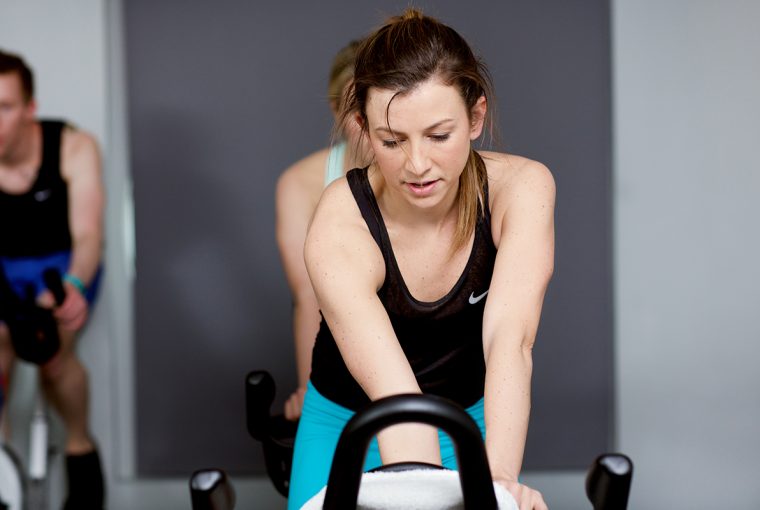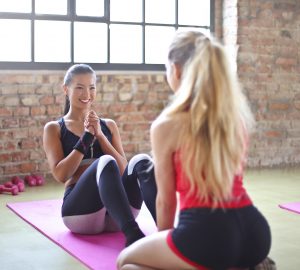Spin class is in a class of its own when it comes to cardio workouts. Crushing the pedals to the beat of the (usually really loud) music, infectious instructor energy and maybe a touch of competitive spirit with the person riding beside you makes this form a cardio almost addictive.
But is spinning, also known as indoor cycling, the best use of your time, depending on your wellness goals? And what are the potential risks people rarely hear about? Let’s take a look at spin class benefits, set the record straight on some of the bad press and learn how to dive into a sensible indoor cycling routine to maximize the benefits of spinning.
What Is Spin Class?
Indoor cycling, also known as spinning or spin class, involves pedaling on a stationary bike, also known as a flywheel, using various levels of speed and resistance. Different positions on the bike are also used to target different muscles. Spinning is actually the trademarked name associated with one particular type of indoor bike, but it’s synonymous with “spin class” and “indoor cycling.”
The spin class definition? It’s a form of exercise using a stationary bike with that focuses on:
- Endurance
- Strength
- Intervals
- High intensity
- Recovery
The concept of riding an indoor stationary bike has been around for some time. In fact, there’s a photo of a woman indoor cycling in the Gymnastics Room of the Titanic in 1912. And long before that, Francis Lowndes patented his “Gymnasticon” in 1796. Other early indoor cycling models resemble a bike set up on rollers.
Things are much different today. Modern-day spin classes generally include charismatic instructors, music and lighting effects. A small study even found that an indoor rider’s sense of pleasure was significantly higher when riding to music during class. Music and dimmed lighting during spinning class actually led to riders feeling less tired after a ride. And interestingly, the music and lighting didn’t cause participants to work harder, but they enjoyed the class more.
Technology also brings even more spinning class opportunities. The Peloton bike, for instance, allows home riders from all over the country to take live and on-demand indoor cycling classes with instructors and riders in New York City.
Top 6 Benefits of Spinning
1. Weight Loss/Calorie Burn/Better BMI
Is spinning a good way to lose weight? Many studies suggest it is, but even if you’re taking indoor cycling classes and don’t see the scale budge, don’t panic. In a small study of female adolescents, researchers found a 16-week spinning program didn’t result in weight loss but did improve BMI chart readings and reduced body fat percentages. It also triggered healthier blood glucose levels.
In another small, but promising, spinning weight-loss study in Italy, researchers found that women leading a sedentary lifestyle experienced the following results without making any changes to their diets.
After 24 spin classes:
- 2.6 percent decrease in body weight
- 4.3 percent reduction in fat mass
- 2.3 percent increase in lean mass
- 6.5 percent lower resting heart rate
After 36 spin class sessions:
- 3.2 percent decrease in body weight
- 5 percent reduction in fat mass
- 2.6 increase in lean mass
- 9 percent lower resting heart rate
- Increase in cardio-respiratory fitness
How many calories do you burn in a 45-minute spin class? That’s a question I get a lot, and of course, the answer varies depending on a number of factors, including your weight and intensity of your workout. But a general calorie-burn range is 400 to 600 calories per hour.
Calorie burn isn’t the only benefit, though. Spinning two to three times a week for three months has the power to greatly increase your exercise capacity, along with lowering triglyceride and cholesterol levels, too.
2. Time-Crunch Friendly
If you’ve only got 20 or 30 minutes for a workout, indoor cycling interval training is a great option because it also pumps up your post-workout calorie burn. Post-exercise oxygen consumption (EPOC), also known as the “afterburn effect,” means your metabolism is revving even though you’re not exercising anymore. It’s one of the top benefits of high-intensity interval training. That’s why so many spin instructors work intervals into spinning classes.
3. Better State of Mind
In psychology, “affect” means how someone experiences feelings or emotions after interacting with some sort of stimuli. A study published in 2015 in the Journal of Mental Health found that taking an indoor cycling ride at home or in an instructor-led class improves your post-exercise mood while diminishing negative emotions. However, participants reported enjoying the instructor-led indoor cycling session more than the solo spin workout.
A 2015 study published in the Journal of Diabetes Complications found a 12-week spinning class also lowered anxiety and depression symptoms in participants. The spinning workouts increased brain-derived neurotrophic factor (BDNF) levels, which helps alleviate central nervous system dysfunction.
4. Leg and Bum Toning
Is spin class good for toning your bum? I consider it a solid butt workout, but recommend using it as a supplement to gluteus medius and gluteus maximus resistance training, not a substitute. (In other words, you’re not off the hook when it comes to clamshells and squats!)
What muscles are used in spinning class? Here are some of the main ones:
- Lateral head of the gastrocnemius
- Hamstrings
- Quadriceps
- Gluteus maximus
Indoor cycling is most commonly known for its cardio benefits, but we now know it can build lower body muscle, too. In 2015, a team of researchers from Japan and the U.S. published a study showing that indoor cycling takes longer than traditional resistance training to build muscle due to a slower hypertrophy rate. Still, spinning does build muscle, particularly in older riders. The researchers concluded that “higher-intensity intermittent cycling may be required to achieve strength gains.”
5. Better for Joints Than Most Other Cardio Exercise
If your joints are begging you to give up on high-impact, long runs, spinning could help fill your cardio void while salvaging your joints. As always, check in with your doctor before beginning a spinning routine. They’ll want to clear you if you have any heart issues, injuries or, recent surgeries or other pre-existing conditions.
6. Community
Whether you’re taking online spinning classes on a Peloton bike or heading to your local gym for a class, one thing is for sure: spinning builds community. And in the exercise world, that also brings accountability and consistency. Who knows, someone in your new spinning class could end up being the inspiration you need to really get back on track.
What You Need to Know About Spin Class (Before Going!)
This is really important if you’re about to hop on a home spin bike or head to a spin studio: Know your limits, monitor your heart rate and resist the urge to overtrain. There are some legit spin class horror stories out there. (Yes, lawsuits about pedal lacerations and getting stuck in pedals are a thing).
But if you use your head, prep properly and understand your limits, hitting the saddle for a ride could be the start of a truly positive, life-changing experience. Before we jump into a spin class Q&A for beginners with one of my favorite indoor cycling instructors, let’s first clear the air regarding some recent bad spinning press.
It’s true that rhabdomyolysis is a risk when you go too hard too soon with most forms of exercise, including indoor cycling. Also known as “rhabdo,” the complex condition involves skeletal muscle quickly breaking down. This leads to the leakage of muscle proteins and other muscle breakdown products from the cell and into the blood. Myoglobin, creatine kinase, aldolase, lactate dehydrogenase and electrolytes are all things that can start leaking out of cells and into the bloodstream when rhabdo sets in.
Symptoms range from none to life-threatening acute kidney failure. And spinning is sometimes the culprit, along with other forms of exercise like CrossFit, weightlifting, long runs and exercising in hot, humid weather.
A new term coined “white-collar rhabdomyolysis” developed as more and more sedentary and untrained working professionals started coming down with the condition due to training too hard too soon. Related to that, a 2016 study published in Internal Medicine Journal found that cases of spinning-induced rhabdomyolysis are on the rise.
Korean researchers found that spinning could be a significant cause of rhabdo in young, unfit women. And symptoms can be severe, requiring hospitalization. The study authors recommendation? Take it easy during your first spinning sessions. Don’t push too hard. (You’ll still get a great workout.)

Thankfully, your first spinning class doesn’t have to take a tragic turn. In fact, spin class can transform your health. To help you get the most out of indoor cycling, I asked Denis Morton, an instructor at Peloton, to share some of his best spin class advice.

Q: How do you help coach someone completely new to spinning to make sure they don’t go too hard too soon?
DM: Almost every ride, I say, “I make suggestions, you make decisions,” which means that I’m suggesting a framework for a workout that, with a little adjustment, can be enjoyed by Olympic athletes and first-timers alike.
Remember that it’s supposed to be fun, and that exercise is intended to strengthen us and help prevent injury. It’s easy to get excited and overdo it, so if at any point you feel uncomfortable with what’s happening, take a moment to back off and reassess.
Everybody is different, so remember that whatever metrics the coach is suggesting (cadence, resistance, intensity and so on) are intended to be adjusted for each individual. What’s right for you may not be exactly what the coach is suggesting, and that’s OK! Have fun, ride at a comfortable pace and intensity, and do what makes you feel good!
Attire & Spin Shoes
Q: What shoes are appropriate for someone’s first indoor cycling class, no matter where they take the class? “What to wear to spin class” is a common question. Any advice?
DM: I always recommend riding in indoor cycling shoes. Cycling shoes have stiff soles that deliver power to the pedal more efficiently, reduce strain on the muscles of the foot and nearly eliminate the possibility of feet slipping out of cages or straps, which can be dangerous when pedaling at speed.
Q: What’s the ideal attire for beginners in spin class?
DM: The ideal attire for indoor cycling should be light and breathable while allowing you to move easily. Avoid heavy, restrictive clothing or anything with straps or accessories that could pose issues during exercise.
Form
Q: What are important ways to check in to make sure proper form is maintained throughout a ride?
DM: If you’re new to an activity, let the staff and/or instructor know. They should take time to make sure beginners are comfortable before starting. The instructor should lead by providing a solid visual example of body mechanics, so start by emulating what the instructor is doing.
Beyond that, good coaches will give frequent cues regarding posture and form, so pay attention. Finally, if you have questions before or after class, don’t be shy. We get into this business because we love helping people, and you won’t be the exception.
Q: Could you share any tips on how to get positioned on a bike? Like how high should the seat be, what are some cues to have good shoulder form and so on?
DM: To get set up, start by adjusting the seat height to the height of your hip when standing next to the bike. That will be a good starting point.
When you’re riding, you want about a 5-to-10 degree bend in your knee when your leg is fully extended. In other words, if your leg is locking when extended or deeply bent at the top of the pedal stroke, find a comfortable middle ground.
From there, bring either foot to the most forward point of the pedal stroke, and adjust the seat forward or back to bring your kneecap directly above the “laces” area of your shoe.
There’s room for adjustment to your comfort here, but the safe range will leave your knee above the front of your shoe at the front of the pedal stroke. Once you’ve adjusted for your lower body, adjust the handlebars so that when your hands are resting on them, you have a moderate forward lean with an easy, natural bend in your elbows. Sitting vertical reduces our power, whereas too extreme a forward lean places strain on the lower back.
You want a long, neutral spine, so aim to avoid arching or rounding your back, and keep your shoulders back and down. This will be a good start, but once you feel comfortable with your setup, don’t be afraid to play with it, or experiment with one adjustment at a time to see if there’s something that works better for you.
Length of Class
Q: What’s the ideal intensity and length of class for a beginner? How does someone know when they’re ready to progress, and what does smart progression look like?
DM: Beginners come in every shape and size. If you’re brand new to exercise or cycling, I recommend trusting your caution — better to take it easy in the beginning and feel confident returning than to risk overexertion or injury.
If you’re already an athlete and it’s just your first cycling class, you may be more comfortable diving into the deep end. As a general rule, start with shorter, less intense classes, and increase the duration and intensity only when you feel comfortable and confident.
Q: Is there anyone who shouldn’t take a spin class?
DM: There are injuries and conditions that might prevent people from cycling, but your safest bet is always to check with a professional healthcare provider before beginning any new exercise routine.
More Spinning Info
Types of Spin Classes/Where to Take Spin Class
Whether you’re logging on to a Peloton account, spinning with YouTube videos or heading to a local gym to spin, find a class that allows you to work at your own pace. And find one that you enjoy!
Look for instructors with spinning and fitness certifications, and ones that encourage you to work at your current ability. Music and time of day of classes are also considerations when looking for a spinning class. Always use a heart rate monitor and use your body as a guide to make sure you’re not overtraining or injuring yourself.
Here are some examples of different spin class rides:
- Beginner
- Intervals
- Rhythm
- Metrics
Precautions About Spinning
Be under control. One of the easiest ways to injure yourself during cycling is to set the resistance too low and pedal too fast. Things can get out of control really fast. You don’t want to overdo it, but aim to set your resistance high enough so your legs are in control. You don’t want to be going too fast orbouncing out of your seat. Be stable.
Beware of rhabdo. As mentioned earlier, spinning-induced rhabdomyolysis is a possible, but rare threat of overtraining on the bike. This is a rare side effect of overtraining, but one to know about so you can take proper steps to prevent it.
The noise factor. A Vox reporter’s investigation found sound levels during some spin classes that actually violate the Department of Labor’s guidelines for a safe noise environment. Spending more than 15 minutes at the 100-decibels noise range the reporter routinely found could cause hearing loss over time. Vox also report this eye-opening stat:
A single 45-minute indoor cycling class was nine times the recommended noise exposure for an eight-hour workday.
A 2016 looking at 17 different spin classes around the Boston area found class music levels routinely rose above 100 decibels.
Overtraining. Too much of any type of over-exercising puts you at risk of overtraining symptoms and side effects. These include:
- Increase in cortisol levels
- Cortisol-related weight gain
- Weakened immune system
- Increased soreness
- Joint pain
- Sleep trouble
- Moodiness
- Digestive distress
- Adrenal fatigue
- Heart damage
- Muscle wasting
- Inflammation
- Missed or irregular periods
Common injuries. Aaptiv identifies the most common indoor cycling injuries as:
- Knee pain (also known as cyclist’s knee or patellofemoral pain syndrome)
- Back and should pain
- Wrist pain
- Foot pain
- Saddle sores
Most of these can be prevented by:
- Training at your current fitness level
- Avoiding overtraining
- Making sure cycle shoes fit properly
- Making sure bike is adjusted to fit you
- Avoiding tense shoulders and hunched over posture
- Strengthening your core
- Avoid leaning too much weight on your handlebars
- Making sure you aren’t completely taking all the bend out of your knee on the downstroke
- Wearing padded bike short initially, if needed
Also, mixing it up is important in exercise because the body adapts and because you don’t want to keep training only one particular set of muscles. If you sit all day and then indoor cycle, you’ll want to pay special attention to hitting exercises that strengthen your core and mid-back area on other workout days.
Final Thoughts on Spin Class
- Taking spin class regularly can help improve lower body strength, lower blood glucose levels, trigger weight loss and improve your BMI and even increase your mood for hours after exercise.
- Avoid overtraining and going too hard too soon to lower your risk of common indoor cycling injuries.
- Always make sure you’re well-hydrated heading into a class (and hydrate during class, too.)
- If noise levels are too high in spin class, approach the instructor and gym and ask for more reasonable levels to preserve hearing health.
- There are opportunities to take a spin class at many gyms, training studios and even in your home.




